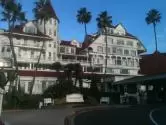A Tale of Two Hotels

Actually, I could have called this a Tale of Three Hotels, but two sounds more Dickensian.
The Minwax Company asked me to fly to San Diego last week to film a morning television show for them. As often happens on these trips, my day started with a very early wake-up call, but we were finished by mid-morning, leaving me with time to drive out to tour the historic Hotel Del Coronado.
The Hotel Del Coronado is a sprawling, five-story wooden hotel built in 1888 in the Victorian style. As the historical marker at the front entrance proclaims, it is one of the largest surviving wooden buildings in the country. The others, we can presume, were either torn down or burnt down. The Del, as the locals call it, is owned by the same private equity firm that recently purchased the Grove Park Inn, so I was anxious to see if the historical character of the hotel had been compromised by the pressure of investor expectations.
Once inside I realized that the current owners had spared no expense in restoring and maintaining the historical integrity of the building. This truly is a Victorian masterpiece, made entirely of wood, which we know is a high maintenance material, especially when it is 125 years old.
As I climbed the stairs to my fifth-floor room with spectacular views of the Pacific Ocean, I could not help but think of another Victorian hotel, one that did not fare so well. In 1886 Asheville’s original Battery Park Hotel, also wooden and also featuring multiple turrets, balconies, electric lights and one of the first hydraulic elevators in the South, opened in downtown Asheville, and soon was hosting United States presidents and touring vaudeville entertainers.
But when the Grove Park Inn opened in 1913, furnished in the popular Arts and Crafts style, the Battery Park Hotel began a steady decline. Ironically, it was E. W. Grove who bought the aging Victorian queen in 1921, but, rather than investing tens of thousands of dollars needed to restore it to its Victorian splendor, he tore it down. More accurately, it burnt down during demolition.
The townspeople of Asheville, who never felt as comfortable at the Grove Park Inn as they did at the old Battery Park Hotel, were outraged at Grove’s blatant disregard for their social center, where weddings and reunions had often been held. He replaced it with a bland, twelve-story brick monolith intended for traveling salesmen. Local historians anxious to put a positive spin on Edwin Wiley Grove’s actions called him the “Father of Modern Day Asheville,” which evokes yet another ironic twist, as we now look at his buildings and neighborhood developments as ‘historic’ when, in fact, Grove had little regard for historic preservation.
Fortunately for us, what E. W. Grove built, he built to last.
The old Battery Park Hotel just got in the way of progress.
But if what I saw at the Hotel Del Coronado is any indication of what is going to happen at the Grove Park Inn, then we can expect the historic character of our Arts and Crafts Mecca will be both preserved and enhanced, remaining true to its Arts and Crafts heritage.
But we can also expect that the cost of preserving and maintaining that same Arts and Crafts heritage will come not from donations, grants or taxpayer dollars, but from user fees. And if the response of those I stood shoulder to shoulder with in the crowded Hotel del Coronado is any indication, people are willing to pay a premium for the rare opportunity to enjoy and appreciate a fully restored historic hotel.

Until next Monday,
Have a great week!
Bruce
For information on the February Grove Park Inn Arts and Crafts Conference, go to http://www.arts-craftsconference.com.
